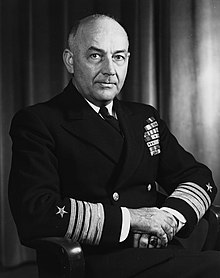Arthur Dewey Struble
| Arthur Dewey Struble | |
|---|---|

Vice Admiral Struble, USN
|
|
| Born |
June 28, 1894 Portland, Oregon |
| Died | May 1, 1983 (aged 88) |
| Allegiance |
|
| Service/branch |
|
| Years of service | 1915–1956 |
| Rank |
|
| Commands held |
Eastern Sea Frontier and Atlantic Reserve Fleet First Fleet Seventh Fleet USS Trenton (CL-11) |
| Battles/wars |
World War I World War II Korean War |
| Awards |
Distinguished Service Cross Navy DSM (2) Army DSM |
Arthur Dewey Struble (June 28, 1894 – May 1, 1983) was a United States admiral served in World War II and the Korean War.
Struble was born in Portland, Oregon. Following graduation from high school in Portland, he entered the United States Naval Academy in 1911 and was commissioned with the rank of Ensign in June 1915. Over the next six years, he served in two cruisers, a supply ship and three destroyers. In 1921–23, Struble was an instructor at the Naval Academy, then served in the battleship California (BB-44) until 1925, when he was assigned to the Battle Fleet staff. From 1927 until 1940, he served twice in Navy Department billets, twice on seagoing flag staffs, in New York (BB-34) and Portland (CA-33), and at the 12th Naval District. In 1940-41, he was Executive Officer of Arizona (BB-39). Captain Struble next commanded the light cruiser Trenton (CL-11) in the Pacific.
Leaving Trenton in May 1942, Struble had duty in the Office of the Chief of Naval Operations until late 1943, when he became Chief of Staff to Rear Admiral Alan G. Kirk, who was responsible for U.S. Navy participation in the Normandy Invasion of June 1944. Rear Admiral Struble was assigned to command a Seventh Fleet amphibious group in August 1944, and participated in the invasion of Leyte the following October. Over the next several months, he commanded or participated in landing operations at Ormoc Bay, Mindoro, Luzon and elsewhere in the Philippines. In September 1945, following the end of the Pacific war, Struble commanded the Pacific Fleet's mine force as it began the long process of clearing mines from the former combat zone. He commanded the Amphibious Force, Pacific Fleet, during 1946–48.
...
Wikipedia
